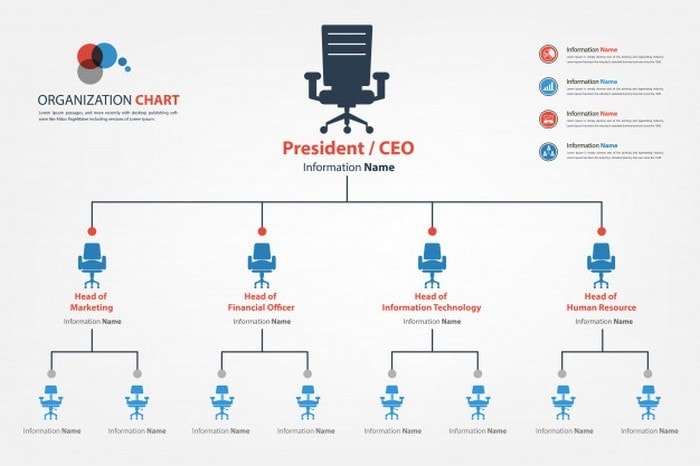The functional organization is designed on the typical hierarchy system where position and job requirement of every employee is defined. The organization is also divided into separate departments that work individually to complete a specific project.
The function of departments depends on the requirement of the project. A functional organization structure is one of the most popular organizational structures that is used to run a business effectively and earn great revenues for the company.
Functional organization structure is suitable for small as well as those entities that offer one type of services or products regularly; for example, medical clinics, car-repairing shops, hotels, and restaurants.
In an organization, you can implement a functional organizational structure in departments like advertising, finance, marketing, sales, and human resources. It enables control over workers without causing conflict between managers.
Are you aware of the latest trends in functional organizations?
Updated Industry Insights: In 2023, a report by Deloitte revealed that 58% of medium-sized enterprises have adopted a functional organizational structure to enhance efficiency and streamline operations. This shift is largely driven by the need for specialized departments that can focus on specific business areas, leading to improved performance and higher revenue growth.
Practical Tips: To effectively implement a functional organizational structure, ensure that each department has clearly defined roles and responsibilities. Additionally, fostering regular communication between departments can help mitigate the common issue of poor inter-departmental coordination. Utilizing collaboration tools like Slack or Asana can facilitate better workflow and enhance overall productivity (Source: Harvard Business Review, 2023).
The employees are well-trained and highly skillful, and they are grouped in accordance with their area of specialization. The workers are placed in appropriate departments where the employees belong to the same type of skill.
They have to report to the functional manager who in turn reports to the higher authority like a CEO or a director.
The manager is an expert in the same field as the employees, and this advantage helps him to utilize, manage, and coordinate the skill of the workers under his authority to achieve optimal work productivity.
Table of Contents
The ideal structure of the functional organization
Every organization needs an efficient organizational structure if it wants to survive and flourish in these competitive times. There will be disorder, chaos, and inefficiency if you do not implement a proper structure that is ideal for your type of business.
Bear in mind that it is the organization that determines the working culture of a place and what is the role and responsibility of an employee in that place.
Remember you have a static role to play in these types of structures and report to the functional manager.
In a functional organization structure, the company is divided into smaller departments or groups, and all the employees are grouped in accordance with the function they are performing.
The organizational chart of this structure shows president at the top and then in downward order vice president, finance department, sales, purchase, administration, etc.
Every single department has a head that is directly responsible for the people working under him. For example, the advertising department puts its onus solely on brand awareness and product visibility whereas sales department on garnering maximum sales for the company. The communication flows not through the lower levels or employees but through department heads to top management brass.
Example of functional organization
A functional organizational structure is perfect for medium and small business houses as well as or companies that have either one or a few product lines. For example, a small business entity AB Company deals in the manufacturing of diapers and has nearly one hundred employees.
It has adopted a functional organizational structure and has created departments for finance, marketing, sales, research, production, administration, and human resources.
All of them report directly to the head. When the company grows, it will start adding further heads and top management officers, but at the beginning, it is a perfect set-up for functional organizational structure.
Features of Functional Organization
The important features of functional organization structure are as follows-
- The functional organization structure determines the weakness and strength of every individual and then places them in specific groups. It assigns task after evaluating their capabilities and makes sure that every task utilizes their skill to maximum capability.
- The functional organizational activity is divided into definite functions and departments like marketing, accounting, and finance.
- The functional organization structure follows a vertical hierarchy system that requires the employee to report to one functional manager.
- An important feature of a functional organization is that it encourages healthy competition amongst its members.
Advantages of functional organization
The advantages of the functional organization are as follows-
- The highly-efficient linear structure helps to give clear instructions to every employee within the department. The execution of the said instructions also becomes easier.
- Employees are highly skilled, and as they are proficient in a particular type of work, it is easy to perform above par because all their energies are focussed on a single goal.
- All the individuals or workers are grouped on the basis of their similar know-how and skills. It results in optimal performance.
- The responsibility of every worker and all the departments are fixed those results in exact accountability of their work. The chain of command is very explicit and clear, and everyone knows which decisions are theirs to make and which to defer to other authorities.
- It becomes easier to monitor the growth and update the training of the employees.
- The organization can easily cultivate the skills of several individuals to create an extraordinary group of specialists.
- Employees do not have to report to multiple heads.
- Every department and every individual in that department has a specific job. Hence the chance of duplication is zero.
- There is a sense of security in the functional organization structure that results in loyal employees who can work without the fear of termination from the employment.
- As communication is clear and open within the department, it results in the further career growth of all the employees.
Disadvantages
The disadvantages of the functional organization are as follows-
- When nearly similar skilled people are working together, conflicts may arise when one employee is promoted whereas others are not.
- As the company starts growing, the departments also become larger. Each one of them becomes a small company in itself because of the number of people working in it. This can result in mismanagement and discord.
- There is a very low level of communication between the two departments, and it results in poor coordination between them.
- The repetitive kind of work can become monotonous and lead to low energy levels.
- In most cases, the employees of one department have little knowledge about the happenings of other departments, and this causes obstacles if any sort of cooperation is needed by one department from another department.
- The department system gives rise to selfish mentality as the heads of every department are only concerned about theirs and are least bothered about the others.
- There is a lack of teamwork between different departments, and this decreases the level of flexibility between them.
- As the functional organization structure is rigid and fixed any sort of change becomes very slow and extremely difficult.
- There is a lack of instant decision making because of the hierarchy in the system.
- As the functional manager has full authority over his department, he can easily make decisions in an autocratic manner. He may consider consulting the team members beneath him, and this sometimes works against the organization.
- The most important disadvantage of functional organization structure is that the departments become too engrossed in their personal goals, and at the end of the day, they start ignoring the goals set up by the organization.
Liked this post? Check out the complete series on Organizational Management


